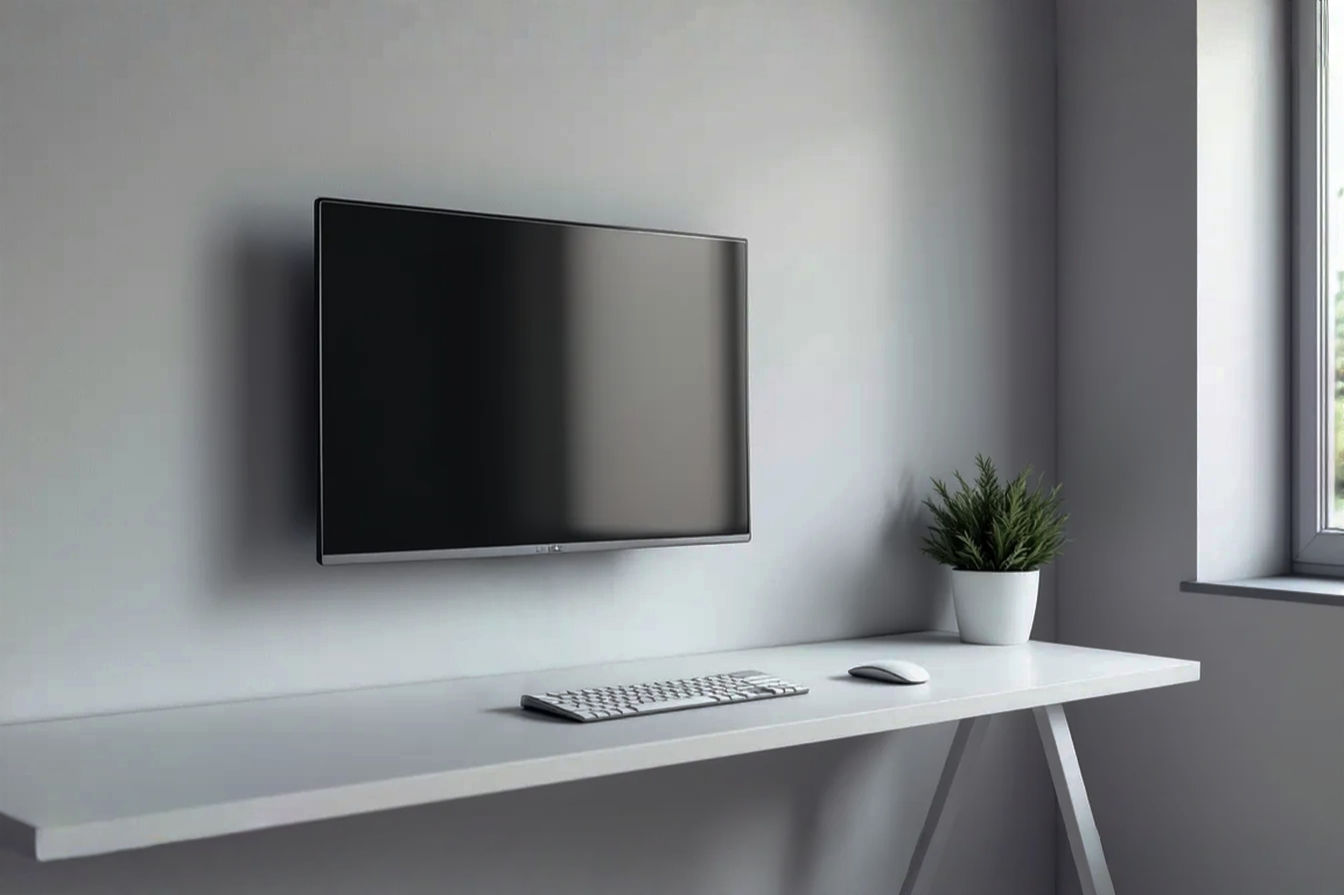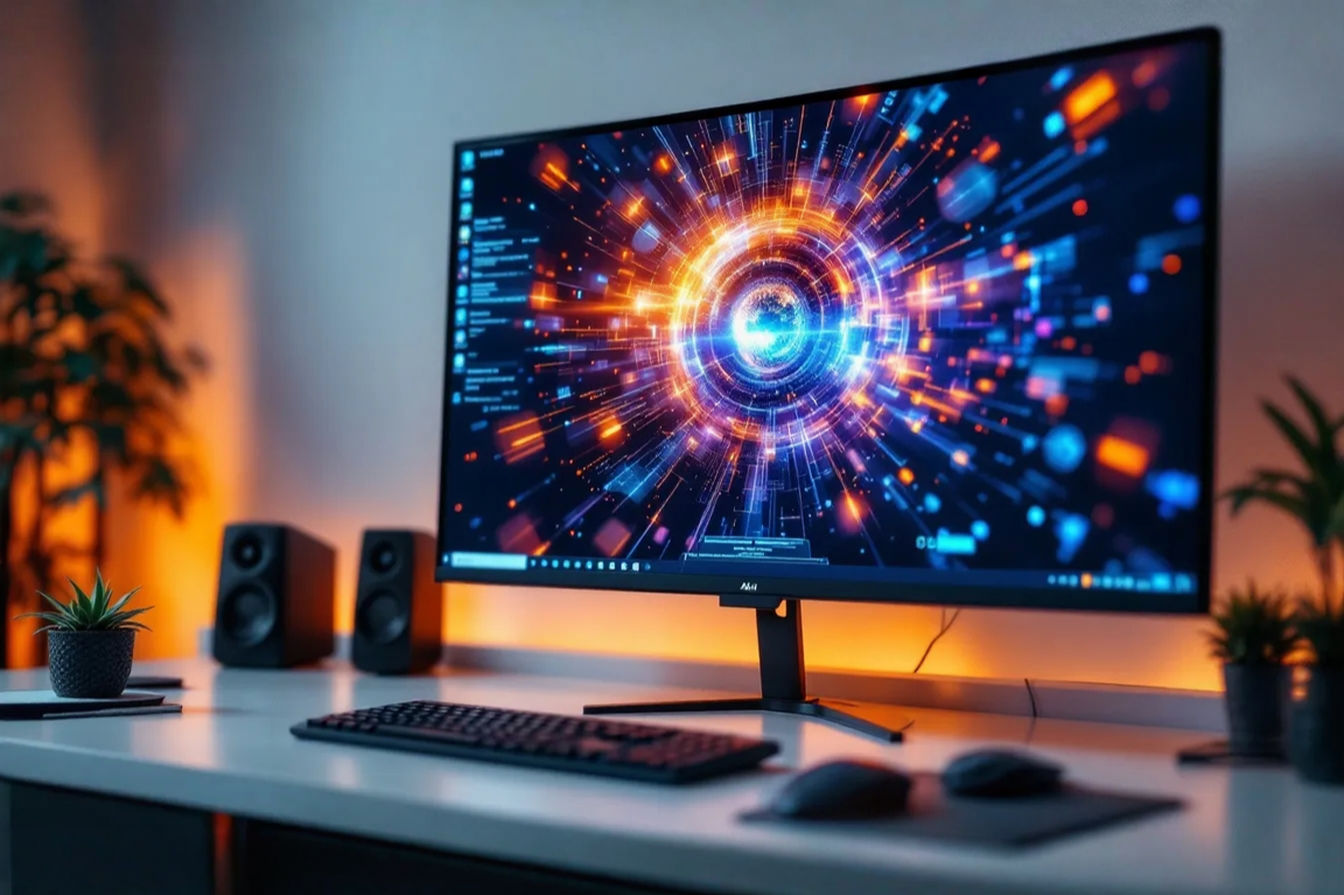This post may contain affiliate links. If you make a purchase through these links, we may earn a commission at no additional cost to you.
Have you ever looked at a friend’s computer screen and thought, “Why does that look so much smoother than mine?” If you’re seeing incredibly fluid motion, especially in games, you might be witnessing the magic of a 144Hz monitor. These displays have become hugely popular, particularly among gamers, promising a visual experience that’s a significant step up from standard screens. But what exactly does 144Hz mean, and is it really worth the hype? This guide will break down everything you need to know about 144Hz monitors, from how they work to whether one is right for you.
What Exactly is Refresh Rate?
Before we dive into 144Hz specifically, let’s talk about refresh rate in general. Think of your monitor as displaying a rapid series of still images, much like a flipbook. The refresh rate is simply how many times per second that image on your screen can update. It’s measured in Hertz (Hz).
A standard monitor typically has a refresh rate of 60Hz. This means the image on the screen can refresh 60 times every second. While this is perfectly fine for everyday tasks like browsing the web or working on documents, it can look a bit choppy when things on the screen start moving quickly.
Now, a 144Hz monitor can update the image on the screen 144 times every second. That’s more than double the updates of a 60Hz screen. This higher rate allows the monitor to display motion with much greater fluidity and detail.
Refresh Rate vs. Frame Rate (FPS)
It’s important not to confuse refresh rate with frame rate, or FPS (Frames Per Second). Frame rate is how many images your graphics card (GPU) is producing per second. Refresh rate is how many of those images your monitor can actually display per second.
Imagine your graphics card is a factory producing pictures, and your monitor is a display board. If the factory is producing 100 pictures per second (100 FPS) but the display board can only show 60 pictures per second (60Hz), you’re only going to see 60 of those pictures. The extra 40 pictures the factory made are essentially wasted, at least in terms of what you see right now.
However, if your display board can show 144 pictures per second (144Hz) and your factory is producing 100 pictures per second (100 FPS), you’ll see all 100 pictures. If the factory ramps up production to 144 pictures per second, your 144Hz display board can keep up and show you every single one, making the motion look incredibly smooth.
So, to truly benefit from a 144Hz monitor, your computer needs to be able to produce frames at a high enough rate to match or exceed the monitor’s refresh rate. We’ll discuss the hardware needed later.
The Tangible Benefits of a 144Hz Monitor
Upgrading to a 144Hz monitor isn’t just about a number; it translates into a noticeable difference in how things look and feel on your screen. Here are the key benefits:
Smoother Motion and Reduced Motion Blur
This is the most immediate and obvious benefit. With the screen updating more than twice as often as a 60Hz monitor, fast-moving objects appear significantly smoother. Instead of seeing a blurry trail behind a moving cursor or a character sprinting across the screen, you see a much clearer, more defined image at each step of the motion.
Think about watching a race car speed by. On a 60Hz screen, it might look like a bit of a streak. On a 144Hz screen, you’ll see more distinct moments of the car’s movement, making the motion feel more natural and less jarring. This reduction in motion blur is particularly important in fast-paced applications.
Enhanced Gaming Experience
This is where 144Hz monitors truly shine for many users. In video games, particularly competitive ones like first-person shooters (FPS) or racing games, every millisecond counts.
- Improved Responsiveness: Because the image updates faster, the time between your action (like clicking your mouse) and seeing the result on screen is reduced. This can make games feel much more responsive and direct.
- Easier Target Tracking: In fast-paced games, being able to clearly see and track moving targets is crucial. The reduced motion blur and smoother visuals on a 144Hz monitor make it significantly easier to follow enemies or objects, giving you a potential competitive advantage.
- Reduced Input Lag (Perceived): While refresh rate isn’t the same as input lag (the delay between your input and the computer processing it), a higher refresh rate reduces the display lag – the time it takes for the new frame to appear on screen. This contributes to a feeling of lower overall input lag.
Many professional esports players wouldn’t consider competing on anything less than a high refresh rate monitor due to these advantages.
Less Eye Strain
While not always the primary reason people upgrade, the smoother motion can lead to less eye strain over long periods. When your eyes have to work harder to track choppy motion or deal with noticeable flickering, it can cause fatigue. The fluid visuals on a 144Hz monitor provide a more comfortable viewing experience.
A More Fluid Desktop Experience
Even outside of gaming, a 144Hz monitor makes a difference. Simple tasks like dragging windows around your desktop, scrolling through long web pages, or even just moving your mouse cursor feel incredibly smooth and fluid compared to a 60Hz screen. Once you’ve experienced it, going back to 60Hz can feel surprisingly sluggish.
How 144Hz Achieves That Silky Smoothness: The Technical Details
We know that a 144Hz monitor updates the screen 144 times per second, but let’s look a bit deeper at the technical side of how this translates to smoother visuals.
The core concept is that the monitor is capable of drawing a new frame much more frequently. On a 60Hz monitor, there’s a gap of about 16.67 milliseconds (ms) between each frame update (1 second / 60 frames = 0.01667 seconds). On a 144Hz monitor, that gap is reduced to approximately 6.94 ms (1 second / 144 frames = 0.00694 seconds).
This smaller time interval between updates means that when something moves across the screen, the monitor can display more intermediate positions of that object. Instead of jumping from point A to point C, it can show point A, then point B (which is closer to C), then point C, and so on. This creates the illusion of much smoother, more continuous motion.
The Importance of Response Time
While refresh rate dictates how often the screen updates, response time dictates how quickly the pixels on the screen can change from one color to another. Response time is typically measured in milliseconds (ms).
If a monitor has a high refresh rate but a slow response time, the pixels might not be able to change fast enough to keep up with the rapid updates. This can lead to issues like ghosting, where you see a faint trail or “ghost” of a previous image as the pixels transition slowly.
For a 144Hz monitor, a low response time is crucial to fully realize the benefits of the high refresh rate. You’ll often see response times advertised as 5ms, 1ms, or even faster (like 0.5ms). Generally, a lower response time is better, especially for fast-paced content. Many gaming monitors specifically highlight their low response times, often using techniques like “Motion Blur Reduction” (MBR) or “Extreme Low Motion Blur” (ELMB) which involve backlight strobing to further reduce perceived motion blur, though these can sometimes introduce flicker.
So, while 144Hz is about the frequency of updates, a fast response time ensures that each update is displayed clearly and quickly without lingering artifacts from the previous frame. Both work together to create that smooth visual experience.
Panel Types and Their Role in 144Hz Monitors
The type of panel technology used in a monitor significantly impacts its performance characteristics, including how well it handles a high refresh rate. The three main types you’ll encounter are TN, IPS, and VA.
TN (Twisted Nematic) Panels
- Pros: Historically the fastest panel type with the lowest response times, making them excellent for high refresh rates like 144Hz and beyond. They are typically the most affordable option.
- Cons: Generally have the poorest color reproduction and narrow viewing angles. Colors can look washed out, and the image quality degrades noticeably if you’re not looking at the screen straight on.
- In the context of 144Hz: TN panels were among the first to reliably achieve 144Hz and are still a popular choice for competitive gamers who prioritize speed and response time above all else. Their speed makes them well-suited to displaying rapid updates without significant ghosting.
IPS (In-Plane Switching) Panels
- Pros: Offer excellent color accuracy and wide viewing angles. Colors look vibrant and consistent even when viewed from the side.
- Cons: Traditionally had slower response times compared to TN panels, though this has significantly improved with newer technology. They can also be more expensive.
- In the context of 144Hz: Modern IPS panels have become much faster, with many now offering 144Hz and low response times (often 1ms GtG – Grey-to-Grey). They are a great option for users who want both high refresh rate performance and good image quality for tasks like content creation or enjoying visually rich games. You get the smoothness of 144Hz combined with better colors and viewing angles than TN.
VA (Vertical Alignment) Panels
- Pros: Offer the best contrast ratios among the three types, resulting in deeper blacks and brighter whites. They provide better viewing angles than TN but not as good as IPS.
- Cons: Can sometimes suffer from slower response times, particularly in transitions from black to grey, which can lead to noticeable “black smearing” or ghosting in dark scenes.
- In the context of 144Hz: VA panels can achieve 144Hz, and their high contrast makes them appealing for immersive gaming experiences. However, you need to pay close attention to the specific monitor’s response time specifications and reviews, as some VA panels are better at handling high refresh rates than others. If the response time isn’t fast enough, the black smearing can detract from the smooth experience the high refresh rate should provide.
Choosing the right panel type for your 144Hz monitor depends on your priorities: speed and budget (TN), color accuracy and viewing angles (IPS), or contrast (VA).
Eliminating Screen Tearing: Adaptive Sync Technologies
Even with a high refresh rate, you can still encounter an annoying visual artifact called screen tearing. This happens when your graphics card sends a new frame to the monitor before the monitor has finished displaying the previous one. The result is that the screen displays parts of two different frames simultaneously, creating a jagged, “torn” look across the image.
This is where adaptive sync technologies come in. The two main players are NVIDIA’s G-Sync and AMD’s FreeSync. Both technologies aim to eliminate screen tearing by synchronizing the monitor’s refresh rate with the graphics card’s frame rate.
How Adaptive Sync Works
Normally, a monitor refreshes at a fixed rate (e.g., 144 times per second). The graphics card, however, renders frames at a variable rate depending on how complex the scene is. This mismatch is what causes tearing.
Adaptive sync technologies allow the monitor to dynamically adjust its refresh rate to match the frame rate output by the GPU. When the GPU finishes rendering a frame, it signals the monitor, and the monitor waits for that signal before refreshing the screen with the new frame. This ensures that the monitor only displays complete frames, eliminating tearing and providing a much smoother visual experience, even if the frame rate fluctuates below the monitor’s maximum refresh rate.
G-Sync vs. FreeSync
- NVIDIA G-Sync: This is NVIDIA’s proprietary technology. Monitors with G-Sync have a special hardware module built in. G-Sync monitors are typically more expensive than FreeSync monitors, but they offer guaranteed performance and quality control from NVIDIA. There are different tiers of G-Sync (G-Sync Compatible, G-Sync, G-Sync Ultimate) with varying levels of performance and features. You need an NVIDIA GeForce graphics card to use G-Sync.
- AMD FreeSync: This is an open standard based on VESA’s Adaptive-Sync technology. It doesn’t require a proprietary hardware module in the monitor, making FreeSync monitors generally more affordable. FreeSync is supported by AMD Radeon graphics cards and, importantly, NVIDIA has enabled support for FreeSync on many of their newer graphics cards (referred to as “G-Sync Compatible” when used with an NVIDIA GPU). Like G-Sync, there are different tiers of FreeSync (FreeSync, FreeSync Premium, FreeSync Premium Pro) offering additional features like Low Framerate Compensation (LFC) and HDR support.
Having adaptive sync on a 144Hz monitor is highly recommended, especially for gaming. It ensures you get the full benefit of the high refresh rate without the distracting visual artifacts of screen tearing.
What You Need to Power a 144Hz Monitor
Simply buying a 144Hz monitor isn’t enough to get the smooth visuals it promises. Your computer needs to be powerful enough to generate frames at a high enough rate to feed that monitor. If your PC can only produce 60 FPS in a game, a 144Hz monitor won’t magically make it run at 144 FPS.
Here’s what you’ll generally need:
A Capable Graphics Card (GPU)
This is the most crucial component. To hit 144 FPS (or close to it) in games, you’ll need a relatively powerful graphics card. The exact GPU required depends heavily on the resolution you’re playing at and the graphical settings of the game.
- For 1080p (1920×1080) at 144Hz: Mid-range to high-end GPUs from the last few generations should be sufficient for many games, especially if you adjust settings. Examples might include an NVIDIA GeForce RTX 3060/4060 or an AMD Radeon RX 6700 XT/7700 XT or better.
- For 1440p (2560×1440) at 144Hz: This is more demanding. You’ll likely need a higher-end GPU like an NVIDIA GeForce RTX 3070/4070 or better, or an AMD Radeon RX 6800 XT/7800 XT or better, to consistently hit high frame rates in modern demanding titles.
- For 4K (3840×2160) at 144Hz: This requires top-tier hardware. You’re looking at GPUs like the NVIDIA GeForce RTX 4080/4090 or AMD Radeon RX 7900 XTX to get anywhere near 144 FPS in many games at this resolution.
Check benchmarks and reviews for specific games and GPUs to get a better idea of the performance you can expect.
A Decent Processor (CPU)
While the GPU does most of the heavy lifting for graphics, the CPU is responsible for game logic, AI, and preparing draw calls for the GPU. A weak CPU can bottleneck even a powerful GPU, preventing it from reaching its full potential and limiting your frame rate. Ensure you have a modern multi-core processor that can keep up with your chosen GPU.
The Right Cables
Not all cables can transmit the data required for high resolutions at high refresh rates. You’ll typically need:
- DisplayPort: This is the most common and recommended connection for 144Hz monitors, especially at higher resolutions (1440p and 4K). Ensure you use a DisplayPort 1.2 cable or newer. DisplayPort 1.4 is required for 4K at 144Hz without compression.
- HDMI: While some older HDMI versions might support 144Hz at lower resolutions (like 1080p), you’ll need at least HDMI 2.0 to support 144Hz at 1440p, and HDMI 2.1 for 4K at 144Hz without compression. Check your monitor and graphics card specifications to see which HDMI version they support.
Using an older or inadequate cable can prevent you from accessing the monitor’s full 144Hz refresh rate.
Is a 144Hz Monitor Right for You?
Now that you understand what 144Hz monitors are and how they work, the big question is: do you need one? The answer depends largely on how you use your computer.
You Should Consider a 144Hz Monitor If:
- You are a PC Gamer: Especially if you play fast-paced or competitive games. The benefits in terms of smoothness, responsiveness, and target tracking can significantly improve your gaming performance and enjoyment. Even in slower-paced games, the improved visual fluidity is a nice bonus.
- Your PC Can Achieve High Frame Rates: As discussed, you need the hardware to push frames at or near 144 FPS to fully utilize the monitor’s capabilities. If your current PC struggles to get above 60 FPS in the games you play, upgrading your monitor might not provide the dramatic improvement you expect unless you plan to upgrade your PC components as well.
- You Value Visual Smoothness: Even for general desktop use, the difference in fluidity when scrolling or moving windows is noticeable and can make your computer feel snappier and more responsive.
- You Spend Long Hours at Your Computer: The potential reduction in eye strain from smoother motion can be beneficial for those who spend many hours working or playing.
A 144Hz Monitor Might Not Be Necessary If:
- You Primarily Use Your Computer for Basic Tasks: If you mainly browse the web, check email, use productivity software, or watch videos, the benefits of 144Hz will be minimal compared to a standard 60Hz monitor. You likely won’t notice the difference in these scenarios.
- You Only Play Very Casual or Slow-Paced Games: For turn-based strategy games, puzzle games, or older titles that don’t require rapid reflexes, a high refresh rate isn’t a critical factor in gameplay or enjoyment.
- Your Current PC Hardware is Not Capable of High Frame Rates: If your graphics card and CPU can’t consistently push frames above 60 FPS, a 144Hz monitor will largely be overkill. You’ll still be limited by your PC’s performance.
- You Have a Tight Budget: 144Hz monitors are generally more expensive than comparable 60Hz models. If budget is a major constraint and the primary use isn’t competitive gaming, you might get better value focusing on other monitor characteristics like resolution, panel type, or size on a 60Hz model.
Ultimately, the best way to know if 144Hz is right for you is to see it in person. If you have a friend with one or can see a display model in a store, compare it side-by-side with a 60Hz monitor. The difference in motion smoothness is often immediately apparent.
Choosing Your 144Hz Monitor: Key Factors
If you’ve decided that a 144Hz monitor is for you, here are the key factors to consider when making your purchase:
Resolution
144Hz monitors are available in various resolutions, with 1080p (Full HD) and 1440p (QHD) being the most common. 4K (UHD) 144Hz monitors exist but are significantly more expensive and require very high-end hardware to drive them.
- 1080p (1920×1080): The easiest resolution to achieve high frame rates at 144Hz. Good for competitive gaming where maximum FPS is the goal, even with less detailed visuals. Pixels might be noticeable on larger screen sizes (27 inches and above).
- 1440p (2560×1440): Offers a good balance between visual detail and performance. Requires a more powerful GPU than 1080p to hit 144 FPS but provides a sharper image. A very popular choice for gamers.
- 4K (3840×2160): Provides the sharpest image but is the most demanding on hardware. Best suited for top-tier gaming rigs and users who prioritize visual fidelity above all else.
Choose a resolution that your PC hardware can comfortably handle at high frame rates.
Panel Type (TN, IPS, VA)
As discussed earlier, your choice of panel type will involve trade-offs between speed, color accuracy, viewing angles, and contrast.
- TN: Fastest response times, best for pure competitive speed, but weakest image quality.
- IPS: Great colors and viewing angles, now much faster and a good all-around choice.
- VA: Best contrast, good for immersive visuals, but check reviews for potential black smearing issues.
Consider what’s most important to you based on your primary use cases.
Response Time
Look for a low response time, ideally 1ms GtG (Grey-to-Grey) or lower, to minimize ghosting and motion blur artifacts, especially on IPS and VA panels. Be aware that advertised response times can sometimes be misleading; look for reviews that test real-world motion performance.
Adaptive Sync (G-Sync or FreeSync)
Highly recommended, especially for gaming, to eliminate screen tearing and ensure a smoother experience even when frame rates fluctuate. Check which technology your graphics card supports and look for a monitor that is compatible.
Connectivity
Ensure the monitor has the necessary ports (DisplayPort 1.2+, HDMI 2.0+ or 2.1) to support 144Hz at your desired resolution. Check your graphics card’s available outputs as well.
Size and Ergonomics
Consider the screen size that fits your desk and viewing distance. Also, look for ergonomic features like height adjustment, tilt, swivel, and pivot to ensure comfortable viewing.
Price
144Hz monitors vary widely in price based on resolution, panel type, features, and brand. Set a budget and look for the best combination of features within that range. Remember that a cheaper monitor might compromise on panel quality, response time performance, or build quality.
Setting Up Your New 144Hz Monitor
Once you’ve got your new 144Hz monitor, setting it up to actually run at 144Hz is crucial. It’s not always plug-and-play at the highest refresh rate.
- Connect the Monitor: Use the correct cable (DisplayPort 1.2+ or HDMI 2.0+ / 2.1) and connect it to the appropriate port on your graphics card.
- Install Drivers: Make sure you have the latest drivers installed for both your graphics card and your monitor (if the monitor came with specific drivers).
- Change Display Settings (Windows):
- Right-click on your desktop and select “Display settings.”
- Scroll down and click on “Advanced display settings.”
- Under “Choose a refresh rate,” select the highest available option, which should be 144Hz. If 144Hz isn’t listed, double-check your cable connection and graphics card drivers.
- Change Display Settings (macOS):
- Open “System Preferences.”
- Click on “Displays.”
- Hold down the “Option” key while clicking the “Scaled” radio button next to “Resolution.” This should reveal a “Refresh Rate” dropdown menu where you can select 144Hz.
- Verify in Games: Some games have their own display settings where you need to select the refresh rate. Go into the game’s graphics or display options and make sure it’s set to 144Hz or the highest available refresh rate.
If you’ve followed these steps and 144Hz isn’t an option, troubleshoot by checking your cable, ensuring it’s plugged into the graphics card (not the motherboard), updating drivers, and checking your monitor’s on-screen display (OSD) settings.
Troubleshooting Common 144Hz Issues
Sometimes, things don’t work perfectly right away. Here are a few common issues you might encounter with a 144Hz monitor and how to troubleshoot them:
Not Getting 144Hz as an Option
- Check Your Cable: As mentioned, this is the most frequent culprit. Ensure you’re using a high-quality DisplayPort 1.2+ or the correct HDMI version (2.0+ for 1440p, 2.1 for 4K) and that it’s securely plugged into both the monitor and the graphics card.
- Check Your Graphics Card Ports: Make sure you’re plugging into a port on your dedicated graphics card, not the ports on your motherboard (which are usually for integrated graphics and may not support high refresh rates).
- Update Drivers: Outdated graphics card drivers or monitor drivers can sometimes prevent the correct refresh rates from being detected.
- Monitor Settings: Some monitors have settings in their OSD that need to be adjusted to enable the full refresh rate, especially when using certain features or inputs. Check your monitor’s manual.
Screen Flickering
- Adaptive Sync Issues: Sometimes, flickering can occur with adaptive sync enabled, especially in certain games or with specific driver versions. Try disabling G-Sync or FreeSync temporarily to see if the flickering stops. Ensure your drivers are up to date.
- Faulty Cable: A damaged or low-quality cable can cause signal issues, leading to flickering. Try a different cable.
- Monitor Defect: In rare cases, flickering can indicate a problem with the monitor itself. If troubleshooting doesn’t help, contact the manufacturer.
Not Hitting High Frame Rates in Games
- Hardware Limitations: Your PC might simply not be powerful enough to reach 144 FPS in the game you’re playing, especially at higher resolutions or graphical settings. Lowering in-game settings can help improve frame rate.
- CPU Bottleneck: As mentioned, a weak CPU can limit your GPU’s performance.
- Background Processes: Close unnecessary applications running in the background that might be consuming system resources.
Beyond 144Hz: 240Hz and Higher
While 144Hz is a significant upgrade from 60Hz and is considered the sweet spot for many gamers, monitors with even higher refresh rates like 240Hz, 360Hz, and beyond are available.
These ultra-high refresh rate monitors offer even greater motion clarity and responsiveness, but the difference is less dramatic compared to the jump from 60Hz to 144Hz. The benefits are primarily noticeable in extremely fast-paced competitive games and require even more powerful hardware to drive such high frame rates. For most users, 144Hz provides an excellent balance of performance and visual smoothness without the significant cost and hardware demands of 240Hz+ displays.
Conclusion: The Smooth Future of Your Display
Upgrading to a 144Hz monitor is one of the most impactful ways to improve your PC experience, particularly if you’re a gamer or simply value incredibly smooth visuals. The ability to display more than double the frames per second compared to a standard monitor results in significantly reduced motion blur, enhanced responsiveness, and a more fluid feel to everything you do on your computer.
While you’ll need capable hardware to fully utilize a 144Hz display, and factors like panel type and response time still matter, the core benefit of that high refresh rate is undeniable. Coupled with adaptive sync technology to eliminate tearing, a 144Hz monitor can transform your visual experience, making everything from competitive gaming to simple desktop navigation feel faster, smoother, and more immersive. If you’re looking for a noticeable upgrade in how your computer looks and feels, a 144Hz monitor is definitely worth considering.






